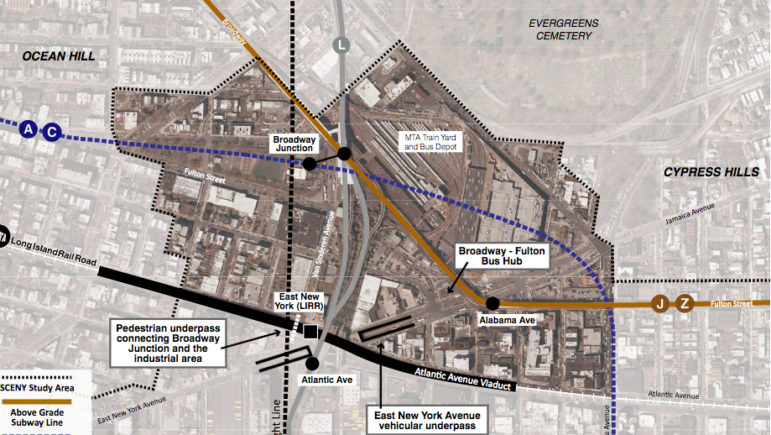
NYCEDC
A look at the study area.
On Thursday, the New York City Economic Development Corporation (EDC) announced it is soliciting applications for the construction of office space in Broadway Junction—potentially signaling the beginning of a larger transformation of East New York’s long-neglected transit hub.
Broadway Junction has repeatedly been identified by the city as a desolate area with great potential for growth due to it rich transit infrastructure: It’s home to five subway lines, a Long Island Railroad station and a large bus depot. The Bloomberg administration’s 2013 Sustainable Communities study put forth one plan for the area, and when the De Blasio administration rezoned East New York in April 2016, the Economic Development Corporation (EDC) and Department of City Planning committed to follow up with a study of their own.
While that study has yet to begin, this spring Borough President Eric Adams has been pressing the city to move municipal agencies to the area to serve as anchor tenants for new commercial developments, and has suggested zoning changes and a reconfiguration of the street layout to allow the construction of new retail and office space.
EDC, for its part, has embraced the idea of moving municipal office space to East New York as part of the administration’s citywide Office Anchor Strategy, which entails providing a stable anchor tenant to encourage commercial development in weaker commercial areas, while freeing up municipal office space for private use in hotter markets. (Creating new office space is a key goal for the administration: it is counting that doing so will create a quarter of the 100,000 new jobs de Blasio has promised he will create over ten years.)
According to the Thursday press release, the city has released a Request for Proposals (RFP) seeking a developer to construct one or more commercial buildings in Broadway Junction, with the Human Resources Administrative as an anchor tenant, and priority given to projects in which at least 50 percent of the development is for use by “local businesses.”
While “local businesses” can, in EDC’s definition, include businesses currently located elsewhere in New York City that want to relocate and bring job opportunities to the neighborhood, EDC is aware of and hopes to meet the needs of existing East New York businesses that need office space, a representative explained.
But like the city’s plan to rezone East New York, the prospect of a revitalization of Broadway Junction has been met with skepticism by some residents, who are not assured the changes are intended to serve them.
At a meeting hosted earlier this month by the Coalition for Community Advancement, an alliance of stakeholders who began organizing around the rezoning, residents voiced a number of concerns, including the importance of renovating the subway station and making it more accessible to disabled residents, the need to ensure existing residents are not displaced by the investment, and the need for development to lead to apprenticeships and good local jobs.
Coalition members interviewed by City Limits on Thursday unanimously recognized the importance of revitalizing the transit hub and creating economic opportunities for the surrounding communities, but also had a number of worries.
District Leader Darma Diaz felt there was already a “lack of community input” in the project, while Michelle Neugebauer, executive director of the Cypress Hills Local Development Corporation, noted many unanswered questions, including how much of the area will be taken up by municipal office space as opposed to badly needed community facilities and other amenities needed by the community, as well as whether the city will offer more than its current local hiring program to ensure East New York residents can obtain good, career track jobs.
Bill Wilkins of the Local Development Corporation of East New York says it’s important the city ensure local stakeholders have a say in the planning, and that the redevelopment includes subsidized, affordable commercial space for existing East New York businesses that desire to relocate and expand.
“It has to be bottom-up economic development to benefit the residents and business of East New York,” he says.
EDC spokesperson Ryan Birchmeier emphasized that the planning for Broadway Junction is only just beginning, that EDC is fully committed to engaging with local stakeholders, and that the office strategy will indeed create benefits for East New York.
“By leveraging the Human Resources Administration as an anchor tenant, we can create office and retail space for growing East New York business and non-profits, as well as businesses looking to create jobs in the neighborhood,” he said in a statement. “What’s more, the Human Resources Administration and its critical social services will be on the ground in East New York.”
Stefan Ringel, a representative for Borough President Eric Adams, also emphasized that there was no site-specific plan for Broadway Junction yet and that Adams’ office would continue to engage in “community-led dialogue.” He said Adams’ hoped to see city investment in Broadway Junction, improved access to HRA services for East New York residents, and commercial revitalization through the anchor-tenant strategy.
“In short, a greater workforce presence combined with existing local purchasing power has the potential to sustain long-term economic prosperity for existing and new small businesses alike,” he wrote in an e-mail to City Limits.








